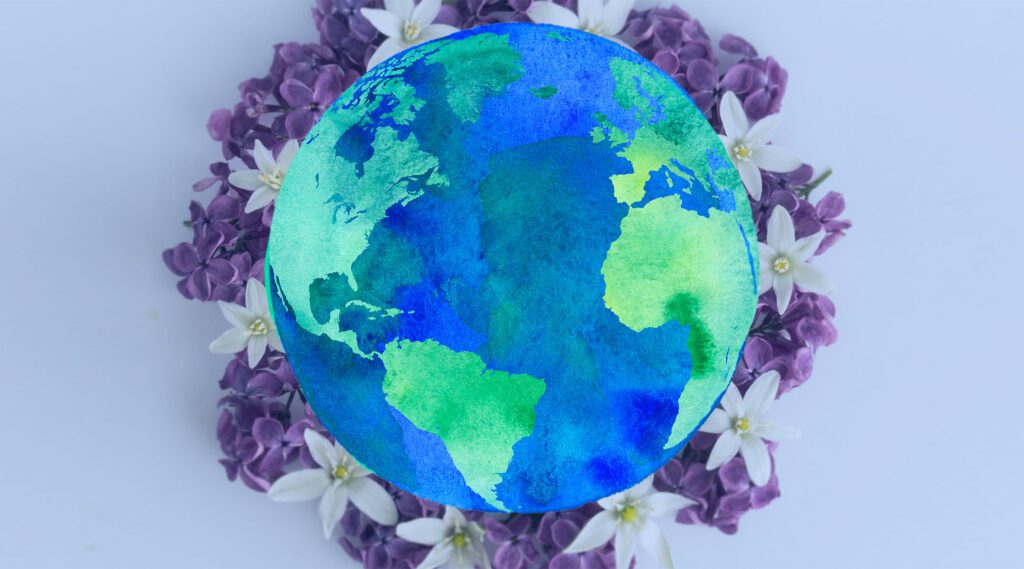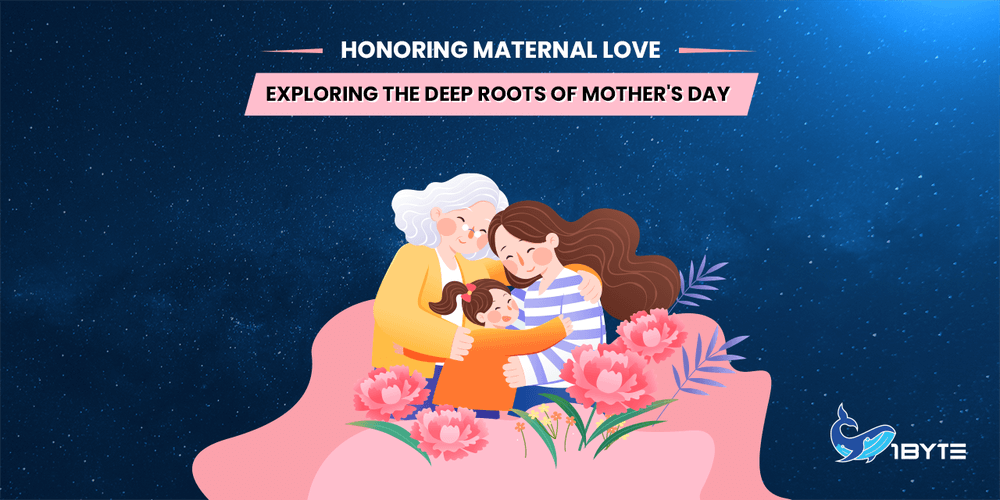-
Historical Origins of Mother's Day
- Ancient roots: Early celebrations of motherhood in ancient civilizations
- Influence of early Christian traditions: The celebration of the Virgin Mary and motherhood in Christianity
- Emergence of modern Mother's Day: The efforts of Anna Jarvis and Julia Ward Howe in the United States
- Adoption and evolution of Mother's Day worldwide: How different countries embraced the holiday
- Mother's Day in the Digital Age
- Conclusion
Come along on a journey into the essence of Mother’s Day 2024, a day devoted to honoring the limitless love of mothers. At 1Byte, we cherish stories, and today, we share the tale of Mother’s Day, a narrative that traverses cultures, continents, and centuries.
Mother’s Day, observed on the second Sunday of May, goes beyond being just a date. It stands as a heartfelt homage to the women who have molded us, stood by us, and loved us unconditionally. This year, Mother’s Day 2024y arrives on Sunday, May 12th, a day dedicated to recognizing the remarkable women who have shaped our lives.
But how did this worldwide celebration originate? Let’s find out in this article.
Historical Origins of Mother’s Day
In this first section, let’s travel back in time to uncover the historical origins of Mother’s Day and explore how this special holiday came into existence.
Ancient roots: Early celebrations of motherhood in ancient civilizations
Imagine traveling back in time to a time when motherhood was recognized in beautiful and meaningful ways. Early forms of honoring mothers existed in civilizations such as ancient Greece and Egypt. They recognized mothers’ crucial role in society, nurturing and influencing the lives of future generations. These ancient societies celebrated motherhood with particular festivals and ceremonies, demonstrating their deep admiration for maternal love. For said societies, women were pillars of strength and leadership, and they wished to recognize their enormous contributions. These events served as a warm thank you to all the mothers who tirelessly cared for their children, passing on wisdom and values.
It’s truly remarkable to observe how these early civilizations recognized and celebrated the importance of motherhood, setting the groundwork for Mother’s Day’s future observance. They saw women as the sustaining forces that kept families and societies together, and they sought to acknowledge that exceptional love. These ancient roots remind us that respect for mothers and their love transcends countries and ages.
Influence of early Christian traditions: The celebration of the Virgin Mary and motherhood in Christianity
Early Christian traditions were also influential in creating the celebration of motherhood. The Virgin Mary is revered in Christianity as the epitome of motherhood and heavenly love. The veneration for Mary as Jesus’ mother has shaped how motherhood is celebrated within the faith. Mary’s constant love, strength, and dedication have come to represent maternal sacrifice and unconditional love. Motherhood is celebrated in Christianity in ways that go beyond biological relationships, emphasizing the spiritual and nurturing elements of motherly love.

Mothers in the Christian community are honored for their great role in leading their children and developing their religion, just as Mary cared for and nurtured Jesus. The adoration of Mary has contributed to a strong regard for mothers’ unselfish love and dedication. The celebration of motherhood received additional significance as a result of the influence of early Christian traditions, emphasizing the holy relationship between mothers and their offspring. It’s a lovely tribute to the enduring tradition of mother love, which continues to inspire and be recognized even now.
Emergence of modern Mother’s Day: The efforts of Anna Jarvis and Julia Ward Howe in the United States
The work of two exceptional women, Anna Jarvis and Julia Ward Howe, who played key roles in the United States, should be credited with the creation of contemporary Mother’s Day as we know it today. Anna Jarvis, a determined mother-honoring advocate, dedicated herself to developing an official day to commemorate and praise mothers’ unselfish love. She relentlessly worked for Mother’s Day to be recognized as a national holiday, inspired by her own mother’s love. Anna’s idea was to establish an emotional event for moms to express their thanks and affection, highlighting the value of valuing them beyond monetary items.
Julia Ward Howe, an influential writer and suffragist, was also a strong advocate for a special day to honor mothers. In 1870, she issued the “Mother’s Day Proclamation,” which urged mothers to join together in peace and against war. Although Julia and Anna had different ideas about Mother’s Day, both ladies shared a strong desire to recognize and uplift moms. Their relentless drive and enthusiasm laid the groundwork for Mother’s Day becoming a recognized holiday. Mother’s Day increasingly acquired awareness and support as a result of their efforts, leading to its official designation as a national holiday in the United States in 1914.
The contributions of Anna Jarvis and Julia Ward Howe remind us of the importance of individual voices in influencing how we respect and cherish maternal love. Their devotion and advocacy started a tradition that continues to touch the hearts of millions of people around the world, encouraging us to express our love and gratitude to the amazing moms in our lives.
Adoption and evolution of Mother’s Day worldwide: How different countries embraced the holiday
Mother’s Day did not remain confined to the borders of the United States; it expanded its wings and found a home in countries all over the world. Each country celebrated the event in its own distinct way, bringing its own ethnic flavors and traditions to the festivities.
People around the world reacted positively to the idea of recognizing and thanking moms as word of Mother’s Day spread. Countries such as Canada, Australia, and Mexico embraced the Mother’s Day concept, aligning it with the principles and sentiments of the American festival.
Mother’s Day, however, evolved as it migrated across continents, adapting to the cultural nuances and historical histories of each region. Mothering Sunday, an earlier Christian ritual, blended with the concept of Mother’s Day in the United Kingdom. In Japan, Mother’s Day has evolved into a chance for children to express their appreciation through meaningful letters and gifts. Antrosht, an Ethiopian celebration, honors mothers and family ties.
We see the universality of maternal love in these gestures while respecting the distinct ways different cultures honor and cherish moms. With its global popularity and expansion, Mother’s Day has become a symbol of unity, reminding us that mothers’ love and dedication transcend borders and languages. It’s heartwarming to see how this celebration of maternal love has evolved into a shared experience, weaving together people from all over the world in a lovely tapestry of admiration and thankfulness.
Mother’s Day in the Digital Age
In this section, let’s explore the beautiful ways in which the digital realm has enhanced our ability to honor and celebrate maternal love on Mother’s Day, bridging the gap between physical distances and bringing us closer to the hearts of the women who have shaped our lives.
Digital expressions of love: The impact of social media and online platforms on Mother’s Day celebrations
Social media and internet platforms have transformed how we express our love and appreciation on Mother’s Day in the digital age, having a dramatic impact on how we celebrate this particular event. Mother’s Day has become a global celebration, stretching beyond physical boundaries and connecting people from all over the world, thanks to the rise of platforms like Facebook, Instagram, and Twitter. We may share our sincere messages, post cherished images, and publicly show our love and thanks for our mothers with only a few clicks.
Because these platforms are instantaneous, our messages of love can travel far and wide, reaching not just our mothers but also our extended networks of friends, relatives, and even strangers. It’s like a virtual megaphone, amplifying our love so that everyone can hear it. We meet in social media’s modern-day town square to commemorate and appreciate the great women who have fostered us. The strength of digital displays of love rests in their capacity to spread like wildfire, inspiring others to join in the celebration and admiration of motherhood. The internet becomes a tapestry of affection, stitched with postings, comments, and shared memories that illustrate the enormous impact moms have on our lives.
Aside from words and photographs, the digital landscape provides a variety of inventive ways to show love, such as personalized movies, special hashtags, and participation in virtual events and campaigns. These digital gestures enable us to go beyond traditional forms of celebration and create one-of-a-kind and meaningful experiences for our mothers and the online community. Mother’s Day has become more accessible, inclusive, and influential than ever before because to social media and online platforms. It links disparate cultures and bridges physical distances, reinforcing the universal essence of mother love.
So, this Mother’s Day, let us embrace digital expressions of love, use these powerful tools to commemorate and appreciate the great mothers who have shaped our lives.
Virtual celebrations: How technology enables long-distance communication and virtual gatherings
Technology has become a lifeline for interacting with our loved ones in the digital world, especially when physical distance separates us. Mother’s Day, with its emphasis on love and togetherness, has taken on a new dimension thanks to technology-enabled virtual gatherings. We can bridge the gap and be there with our mothers no matter how far apart we are thanks to video calls, messaging apps, and virtual platforms. It’s as if we had a virtual teleporter that transfers us into their presence, where we can see their smiles, hear their voices, and experience priceless moments together.

Distance no longer prevents us from commemorating Mother’s Day in a meaningful way. We may now digitally assemble with our mothers, siblings, and extended family members to share memories and have sincere dialogues. We may organize a virtual feast, with each family member bringing their favorite food, and share stories and laughs as if we were all seated at the same table. On this particular day, the digital sphere has given us the ability to transcend physical restrictions and be emotionally present with our mothers.
Whether it’s a touching video conversation, a virtual gift exchange, or a surprise online party, technology has made it possible to create virtual celebrations that are as meaningful and heartfelt as in-person gatherings. It’s a monument to our love’s tenacity and the power of technology to bring us together even when circumstances keep us apart. So, this Mother’s Day, let us embrace these virtual celebrations, using technology to express our love, build our friendships, and create lasting memories with the great women who have influenced our lives.
Online shopping and e-commerce: Transforming the way gifts are purchased and delivered
Online buying and e-commerce have transformed the way we pick and send Mother’s Day presents in the internet age. It’s like having an entire shopping mall at our fingertips, accessible anytime and anywhere. We may browse through a wide choice of things, from personalized jewelry to thoughtful gift baskets, all from the comfort of our own homes, with just a few clicks.
The ease of use is unrivaled, relieving us from the inconvenience of congested stores and long lines. Online platforms include thorough product descriptions, customer evaluations, and even recommendations, making it easy to select the perfect present that matches our mothers’ tastes and preferences. Once the gift has been selected, the shipping process is simple. Even if the receiver lives in a different city or country, we can offer their address and have the gift shipped directly to their door. It’s as if our affection is being wrapped in a virtual package and delivered with care.
Furthermore, during the Mother’s Day season, many online stores provide special specials and discounts, allowing us to locate meaningful gifts while staying within our budget. We can now explore a plethora of possibilities, find unique and customised gifts, and surprise our mothers with something truly unique thanks to the digital marketplace. Furthermore, online shopping allows small businesses and artists to promote their creations, allowing us to support local entrepreneurs while also discovering one-of-a-kind gems with greater meaning.
Mother’s Day has evolved into a celebration of not only maternal love, but also the creativity and craftsmanship of innumerable creative individuals all over the world, thanks to the rise of e-commerce. So, let us embrace the convenience and limitless possibilities of internet shopping as a means of expressing our love and thanks through thoughtful and meaningful gifts that celebrate the amazing mothers in our lives.
Leverage 1Byte’s strong cloud computing expertise to boost your business in a big way
1Byte provides complete domain registration services that include dedicated support staff, educated customer care, reasonable costs, as well as a domain price search tool.
Elevate your online security with 1Byte's SSL Service. Unparalleled protection, seamless integration, and peace of mind for your digital journey.
No matter the cloud server package you pick, you can rely on 1Byte for dependability, privacy, security, and a stress-free experience that is essential for successful businesses.
Choosing us as your shared hosting provider allows you to get excellent value for your money while enjoying the same level of quality and functionality as more expensive options.
Through highly flexible programs, 1Byte's cutting-edge cloud hosting gives great solutions to small and medium-sized businesses faster, more securely, and at reduced costs.
Stay ahead of the competition with 1Byte's innovative WordPress hosting services. Our feature-rich plans and unmatched reliability ensure your website stands out and delivers an unforgettable user experience.
As an official AWS Partner, one of our primary responsibilities is to assist businesses in modernizing their operations and make the most of their journeys to the cloud with AWS.
Conclusion
As we’ve dug deeper into the history of Mother’s Day, it’s evident that this special day is extremely important in our lives and society. Mother’s Day is a monument to the enduring relationship between a mother and her child, from its ancient origins to modern-day celebrations. It is a celebration of unconditional love, sacrifice, and the incalculable influence moms have on our lives. Various cultures and individuals have contributed to the formation of Mother’s Day over time, developing it into the significant and cherished holiday that it is today.

